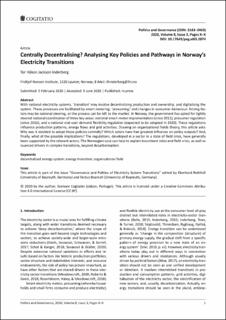| dc.contributor.author | Jackson Inderberg, Tor Håkon | |
| dc.date.accessioned | 2020-08-24T10:49:12Z | |
| dc.date.available | 2020-08-24T10:49:12Z | |
| dc.date.created | 2020-07-31T13:47:31Z | |
| dc.date.issued | 2020 | |
| dc.identifier.issn | 2183-2463 | |
| dc.identifier.uri | https://hdl.handle.net/11250/2673593 | |
| dc.description.abstract | With national electricity systems, ‘transition’ may involve decentralising production and ownership, and digitalising the system. These processes are facilitated by smart metering, ‘prosuming,’ and changes in consumer behaviour. Driving factors may be national steering, or the process can be left to the market. In Norway, the government has opted for tightly steered national coordination of three key areas: national smart-meter implementation (since 2011), prosumer regulation (since 2016), and a national end-user demand flexibility regulation (expected to be adopted in 2020). These regulations influence production patterns, energy flows and grid activities. Drawing on organisational fields theory, this article asks: Why was it decided to adopt these policies centrally? Which actors have had greatest influence on policy outputs? And, finally, what of the possible implications? The regulations, developed in a sector in a state of field crisis, have generally been supported by the relevant actors. The Norwegian case can help to explain incumbent roles and field crisis, as well as nuanced drivers in complex transitions, beyond decarbonisation. | |
| dc.language.iso | eng | |
| dc.subject | Energipolitikk | |
| dc.subject | Energy policy | |
| dc.title | Centrally Decentralising? Analysing Key Policies and Pathways in Norway's Electricity Transitions | |
| dc.type | Peer reviewed | |
| dc.type | Journal article | |
| dc.description.version | publishedVersion | |
| dc.subject.nsi | VDP::Statsvitenskap og organisasjonsteori: 240 | |
| dc.subject.nsi | VDP::Political science and organisational theory: 240 | |
| dc.source.volume | 8 | |
| dc.source.journal | Politics and Governance | |
| dc.source.issue | 3 | |
| dc.identifier.doi | 10.17645/pag.v8i3.2874 | |
| dc.identifier.cristin | 1821145 | |
| dc.relation.project | Fridtjof Nansens institutt: 481 | |
| dc.relation.project | Norges forskningsråd: 295704 | |
| dc.relation.project | Fridtjof Nansens institutt: 477 | |
| dc.relation.project | Norges forskningsråd: 295062 | |
| cristin.ispublished | true | |
| cristin.fulltext | original | |
| cristin.qualitycode | 1 | |
